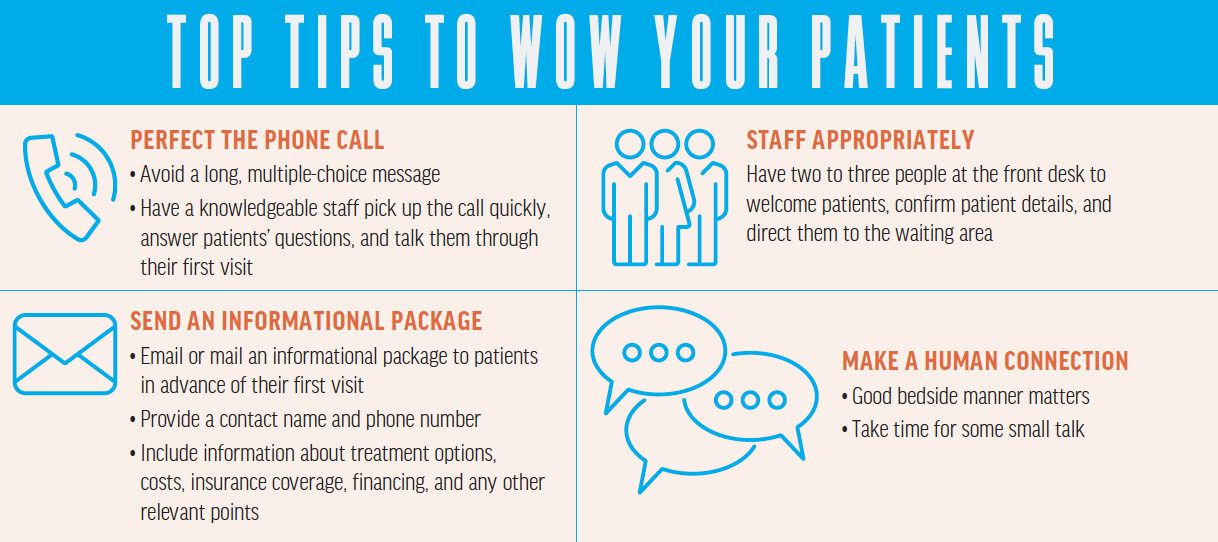
The invitation to write this article prompted recollections of practices I’ve visited, other articles I’ve written, presentations I’ve given on best practices, and entries I’ve reviewed for the ESCRS Practice Management Marketing Competition. I realized that, yes, marketing is important, as is a comfortable waiting room for patients. Assuming, however, that a practice is offering the highest standard of care, what matters most to patients is how they feel at every touchpoint during their visit. This starts with their first point of contact—whether it’s your website or a phone call—and extends to the welcome they receive when they walk in the door, their time in the waiting room, their interactions with the staff, and their discussion with the surgeon.
FIRST POINT OF CONTACT
For the purposes of this article, I am going to assume that your practice’s website is set up to carry prospective patients through the funnel to making an appointment. (If that’s not the current situation, click here to read an article on the topic from CRST Europe’s Progressive Practice column.)
Patients’ first point of contact with your practice is usually the phone call to make their first appointment. What happens when the call connects? Do they hear a minute-long menu directing them to press 1 for this and 2 for that, or do they connect with a human being?
A frequent assignment of mine over the years has been to secret shop a practice by calling the clinic while posing as a patient seeking information. Once, when reporting on my research, I described a practice whose phone line was either consistently busy or unanswered, and two sheepish surgeons approached me after the presentation to ask if I had been referring to their practices. (One of those surgeons was, in fact, from the guilty practice, but both were clearly concerned about how their staff handled the phone.)
To put it bluntly, the first phone call matters. The experiences I remember are when someone picked up quickly, answered my questions, and talked me through how the process would work once I walked through the clinic’s doors. What should be avoided is a long, multiple-choice message that leaves prospective patients confused and hanging up. If the team answering the phone lines is tied up, make it easy for a prospective patient to leave a message and make sure the staff is instructed to call them back as soon as possible.
KEEP THE WOWS COMING
Follow-through. Want to further impress prospective patients before their first appointment? Email or mail an informational package to them in advance. This reenforces the phone call and helps patients prepare for the visit. Provide a contact name and phone number they can call with questions before the appointment. Include information about treatment options, costs, insurance coverage, financing, and any other relevant points. Make it easy for patients to research their treatment options.
Welcome. Having more than a few people in front of me in line at a business or store makes me want to head for the exit. People generally expect efficient, personal service. Someone—particularly a first-time visitor—will view it as a bad sign if they walk into your clinic, find themselves at the end of a long queue, and see only one person managing the check-in process. During peak hours, ensure that two to three people are at the front desk to welcome patients, confirm patient details, and direct them to the waiting area.
Your team should know if a patient is visiting for the first time or returning after not being seen for an eye examination in 3 years. This familiarity can make patients feel known and welcome.
The waiting area. The COVID-19 pandemic has made a waiting room packed to the rafters something everyone wants to avoid. This has necessitated spacing out appointments and furniture, which is not necessarily a bad thing.
What also matters—whether your clinic décor is posh or simple—is sufficient seating, cleanliness, and reading material that doesn’t look like it’s been handled hundreds of times. Is there a restroom that’s easily accessible for patients? A place where they can hang their coats and store umbrellas? This is obvious stuff, but it is what people notice.
HUMAN CONNECTION
What makes someone recommend a doctor to a friend or family member? For me, it’s the practitioner’s bedside manner. My primary care physician is hugely popular where I live. If someone asks for a referral to a general practitioner in the English-speaking community, chances are good that he will be at the top of the list. He is funny; with a big smile on his face, he once suggested cutting off an infected finger of mine. He takes the time to listen. Most importantly, he pays attention to each patient, and he knows when to nag someone about regular blood tests and when it’s time for a colonoscopy. When I visit his office, even if it’s for a prescription refill, I feel well cared for.
When your schedule is packed and you have only 10 minutes to review the results of diagnostic tests and examine a patient, it is the human connection that makes the difference. Particularly if the patient is there to see you about presbyopia correction or a refractive procedure, taking time for some small talk can make a difference.

CONCLUSION
Reviewing my past 15 years of work led me to an obvious conclusion: Winning patients for life is about getting the basics right and making them feel seen, heard, and well cared for (see Top Tips to Wow Your Patients). Free coffee and tea and validated parking help, as do freshly made waffles on Thursdays for patients visiting for clinical study follow-up visits at one practice I frequently visit. The perks don’t matter, however, if the phones aren’t answered, your team is not welcoming, or you make it clear that you are having a bad day.




